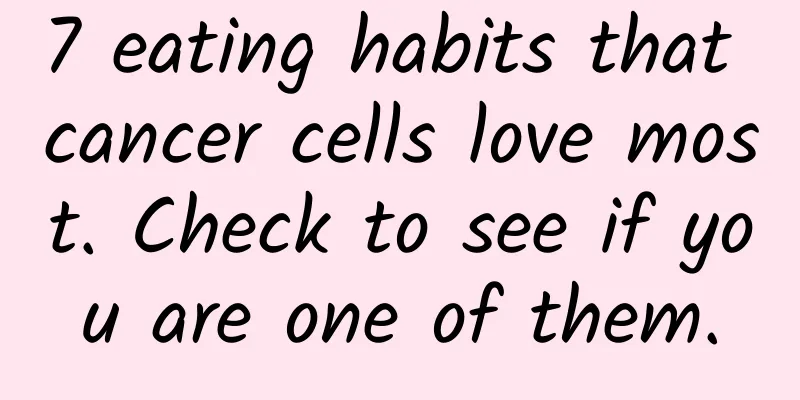7 eating habits that cancer cells love most. Check to see if you are one of them.

|
How do you get cancer? This is a question that many people are concerned about. As we all know, the causes of most cancers have not been fully understood, but there is a basic consensus that cancer is not caused by a single factor, but by the combined effects of multiple factors. The so-called multiple factors include genetic factors (internal factors) and environmental factors (external factors). Environmental factors do not just refer to the air quality and atmospheric environment that we usually talk about, but refer to various external factors, including physical factors, chemical factors, biological factors, lifestyle and dietary factors, etc. The word "cancer" is very interesting, as it contains three "口", which seems to imply the relationship between cancer and diet. In fact, diet and cancer are closely related. What is the relationship between cancer and diet? What kind of eating habits are most likely to cause cancer? Let's first understand the classification of carcinogens. Class 1 carcinogens: Carcinogens that are determined to be man-made. Class 2A carcinogens: are likely to cause cancer in humans. There is limited evidence of the carcinogenicity of this type of carcinogen in humans, but sufficient evidence of its carcinogenicity in experimental animals. Class 2B carcinogens: may cause cancer in humans. The evidence of carcinogenicity of this type of carcinogens in humans is limited, and the evidence of carcinogenicity in experimental animals is insufficient; or the evidence of carcinogenicity in humans is insufficient, but the evidence of carcinogenicity in experimental animals is sufficient. 1. Smoking and drinking make things worse Tobacco and alcohol are both Class 1 carcinogens. Tobacco includes smoking, secondhand smoke, smokeless tobacco, and various tobacco products; alcohol includes all alcoholic beverages, acetaldehyde related to alcoholic beverage intake, and ethanol in alcoholic beverages. Smoking and drinking, this is a cliché, but it is worth repeating. Too many people don't really do it. Tobacco contains thousands of harmful chemicals, dozens of which can directly cause cancer. Smoking is one of the most important risk factors for lung cancer, which has been proven by a large number of studies and facts. Smoking also increases the risk of oral and pharyngeal cancer, esophageal cancer, stomach cancer, bladder cancer, kidney cancer, breast cancer and many other cancers. The harm of secondhand smoke cannot be ignored either. Studies have shown that smokers' families have a higher risk of cancer, and children are the biggest victims. Copyright images in the gallery. Reprinting and using them may lead to copyright disputes. Drinking also increases the risk of cancer. The World Health Organization once issued a cancer monitoring report, pointing out that "we should pay attention to diet and the role of alcohol in carcinogenesis", warning people that alcohol can cause cancer. Studies have shown that long-term alcoholism is mainly related to liver cancer, esophageal cancer, stomach cancer, oral cancer and pharyngeal cancer. Drinking and smoking have a synergistic carcinogenic effect. Smoke and alcohol can cause direct damage to epithelial tissues in the mouth, throat, esophagus, stomach, etc., and alcohol, as an organic solvent, can also promote certain chemical carcinogens in smoke to enter the body tissues better and be released to produce carcinogenic effects. Smoking and drinking alcohol are mistakes on top of mistakes, and the risks are compounded. One plus one is greater than two. 2. Meat-loving people may lead to cancer Red meat (ingestion) is a Class 2A carcinogen; processed meat (ingestion) is a Class 1 carcinogen. Red meat is a term in nutrition. It refers to the color of meat. It refers to meat that is red before cooking. Specifically, pork, beef, mutton, venison, rabbit, etc. Most mammal meat is red meat, which contains high saturated fat. White meat, on the other hand, refers to meat with fine muscle fibers, low fat content, and usually light-colored (white) before cooking, such as chicken, duck, goose, fish, shrimp, shellfish, crab and other non-mammal meat. The cancer research institute under the World Health Organization has classified red meat in the Class 2A carcinogen list. Eating too much red meat increases the risk of colorectal cancer. But this does not mean that you should not eat red meat. Red meat is rich in minerals, especially iron, and is also rich in protein, vitamin B12, thiamine, riboflavin and phosphorus. The nutritional components and nutritional value of red meat and white meat are different. You cannot simply use white meat to replace red meat. Red meat also has irreplaceable value. You can eat red meat, but you must control the amount appropriately and do not eat it too much. What is processed meat? As the name suggests, it refers to processed meat. Specifically, it is meat that has been salted, air-dried, fermented, smoked or otherwise processed to improve the taste or extend the shelf life, such as sausages, hot dogs, ham, bacon, etc. In the list of carcinogens of the cancer research institute under the World Health Organization, processed meat (intake) is classified as a Class 1 carcinogen. Eating processed meat products can cause colorectal cancer/significantly increase the risk of cancer. It is recommended to eat fresh meat as much as possible. It is usually not a big problem to eat a little to satisfy your appetite occasionally, but you should know that there is no so-called safe dose for cancer, it is just a matter of different probabilities. Eat as little as possible. 3. Frying, roasting, pickling and salting can cause cancer Chemicals produced by incomplete combustion of grilled and smoked foods, such as benzo[a]pyrene, are Class 1 carcinogens; Chinese-style salted fish is a Class 1 carcinogen; deep-frying and high-temperature emissions are Class 2A carcinogens; and traditional Asian pickles are Class 2B carcinogens. Grilled food is very popular. There are grilled fish and grilled meat restaurants all over the streets, with tempting aromas. Fried foods, represented by fried dough sticks, are one of the standard features of Chinese breakfast. Pickled foods are even more popular. Many of these foods are made at street stalls. Whether the food hygiene is up to standard or the ingredients are fresh is not the point. The key is that they contain carcinogens, such as benzopyrene, acrylamide, and nitroso compounds, which increase the risk of many cancers, especially digestive tract cancer. It may not be a big problem to eat it occasionally to satisfy your craving, but it is recommended to avoid eating it as much as possible, eat as little as possible, and not eat it often. Eating too much salt not only increases the risk of high blood pressure, but a high-salt diet can also damage the gastric mucosal barrier and increase the risk of gastric cancer. Some people like to eat pickles and salted fish, which are appetizing and go well with rice, but are unhealthy. In addition to causing excessive salt intake, they also contain nitrosamine compounds, which increase the risk of gastric cancer. Copyright images in the gallery. Reprinting and using them may lead to copyright disputes. 4. Expired mold, "poison" causes cancer Aflatoxin is a Class 1 carcinogen. Due to improper storage or expiration, food is prone to mold. Such moldy and expired food contains certain fungi and their metabolites, such as aflatoxin, which can reduce nitrates to nitrites and promote the synthesis of nitrosamines, increasing the risk of cancer, such as liver cancer. 5. Hot food and drinks can cause cancer Hot drinks (drinking) above 65℃ are Class 2A carcinogens. Hot food (over 65°C) can easily burn the esophageal mucosa. Once it becomes a habit, the esophageal mucosa will be repeatedly damaged and irritated, resulting in chronic esophagitis, which will eventually increase the risk of esophageal cancer. 6. Eating betel nuts can lead to cancer Betel nut (containing tobacco or betel nut chewing pieces containing tobacco) is a Category 1 carcinogen. Residents in some places have the habit of chewing betel nuts. It has become a habit to chew a betel nut whenever they have time. The edible betel nuts include betel nuts, betel nut chews containing tobacco, and betel nut chews without tobacco. The World Health Organization clearly lists betel nuts as a Class 1 carcinogen. Why does betel nut cause cancer? Betel nut is hard and may mechanically damage the oral mucosa during chewing. This damage accumulates over time and can lead to oral submucosal fibrosis, a precancerous lesion that may turn into oral cancer. At the same time, some chemicals in betel nut may form nitrosamine (a clear carcinogenic compound) after chewing. In addition to oral cancer, chewing betel nut is also correlated with the occurrence of pharyngeal cancer, laryngeal cancer, esophageal cancer, etc. 7. Bad eating habits can lead to cancer Bad eating habits are also an important risk factor for cancer. Some people eat too fast, overeat, and do not chew slowly, which may damage the digestive tract mucosa, cause chronic inflammation and hyperplasia, and cause poor digestion and absorption. Overeating for a long time also increases the gastrointestinal burden and makes gastrointestinal function easily disordered. In addition, irregular diet, irregular meals, one meal is too fast and the other is too full, and overeating will cause long-term damage to the esophagus and stomach, which also increases the probability of cancer. Some people have a habit of partial eating, unbalanced nutrition, insufficient or excessive nutrition, and unreasonable matching, which may increase the risk of cancer. Others are accustomed to high-sugar and high-calorie diets, and are overweight and obese, which also increases the risk of cancer. Copyright images in the gallery. Reprinting and using them may lead to copyright disputes. Food is the most important thing for people. Eating right may prevent cancer; eating wrong may cause cancer. From today on, let's pay attention to our eating habits. Cancer prevention starts with the details. Although a scientific diet cannot guarantee that you will not get cancer, it can help us reduce the risk of cancer. Planning and production This article is a work of Science Popularization China-Starry Sky Project Produced by: Science Popularization Department of China Association for Science and Technology Producer|China Science and Technology Press Co., Ltd., Beijing Zhongke Xinghe Culture Media Co., Ltd. Author: Pan Zhanhe, Chief Physician, Master's Supervisor, Department of Oncology, Zhongshan Hospital, Xiamen University Reviewer: Tang Qin, Director and Researcher of the Science Popularization Department of the Chinese Medical Association Planning丨Zhong Yanping Editor: Zhong Yanping |
<<: There is a dragon named "Zhu Po" - the prototype of the dragon is the Yangtze alligator?
>>: There are actually “counterfeit goods” in the nut gift package?
Recommend
The Earth's "two-faced" inner core rotates faster than the surface
What causes the differential rotation of the Eart...
How to quickly improve website rankings? How to quickly improve keyword rankings?
Friends who study SEO know that after learning SE...
Why is the food cooked on an induction cooker always not as delicious as that cooked on a gas stove? Here comes the truth
I don't know if you have Have you ever cooked...
How to use traffic dividends to acquire customers at low cost?
In an environment dominated by traffic giants suc...
What is bidding hosting?
The so-called bidding hosting mainly refers to th...
Why do earthquakes occur frequently in Sichuan?
Yesterday, a magnitude 6.8 earthquake occurred in...
The dolphin that swam with its dead cub for more than a month was named Lin
On August 18, 2023, we found a strange Chinese wh...
OPPO R9 unboxing photos: It captured the hearts of female users
OPPO R9 is destined to be another controversial p...
How to configure server rental parameters for websites with large daily traffic?
When renting a server, many companies are still c...
The cute "Hedwig" is actually a bird of prey?
Audit expert: Wang Lei National Parks and Conserv...
Changsi Advertising makes full efforts to help "Fishing Master 3" win the championship again
Mobile advertising revenue will reach 31.5 billio...
What are the techniques for promoting soft articles on Weibo?
Nowadays, the Internet industry is developing rap...
How much does it cost to develop a preschool education app in Kizilsu?
Is it easy to develop a Kizilsu preschool educati...
Gently awaken the "sleeping" seeds
Forage seeds: a bridge between ecology and animal...
10 tips for new operations people to help you avoid operations pitfalls!
After I wrote some operation articles in Product ...









